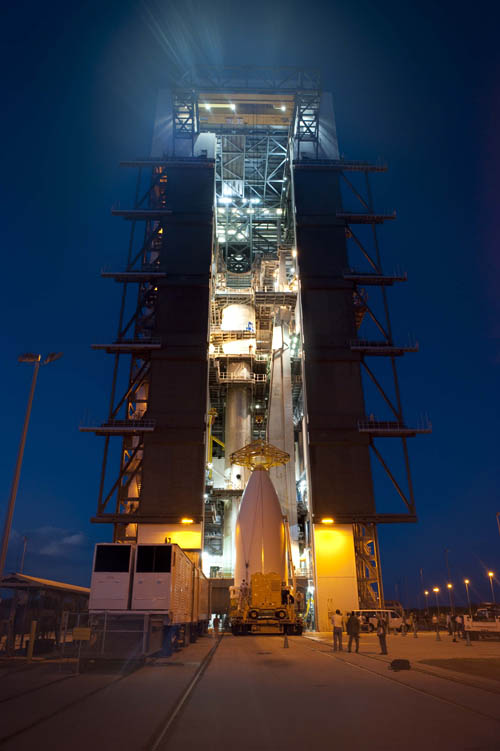Z
Zipi
Guest
Launch window: 11:07-13:06 GMT (7:07-9:06 am EDT)
Launch site: SLC-41, Cape Canaveral Air Force Station, Florida
The United Launch Alliance Atlas 5 (AV-019) rocket will launch the first Advanced Extremely High Frequency (AEHF) satellite. Built by Lockheed Martin, this U.S. military spacecraft will provide highly-secure communications. The rocket will fly in the 531 vehicle configuration with a five-meter fairing, three solid rocket boosters and a single-engine Centaur upper stage. Delayed from July 2009.
United Launch Alliance's Launch Information Page: http://www.ulalaunch.com/site/pages/Launch.shtml#/9/
AEHF Wikipedia Article: http://en.wikipedia.org/wiki/Advanced_E ... _Frequency
Spaceflight Now's Article: http://spaceflightnow.com/atlas/av019/100610prep.html
Lockheed Martin's AEHF Page: http://www.lockheedmartin.com/products/ ... index.html
Lockheed Martin's AEHF Animation: http://www.lockheedmartin.com/data/asse ... _DISC2.mp4
Lockheed Martin's AEHF Overview Video: http://www.lockheedmartin.com/data/asse ... _DISC1.mp4
Lockheed Martin's AEHF Fact Sheet: http://www.lockheedmartin.com/data/assets/ssc/aehf/C10010_AEHFFactsheet_V2(Final)June2010.pdf




Atlas 531 Launch Vehicle
Atlas 5 Wikipedia Article: http://en.wikipedia.org/wiki/Atlas_V
ULA's Atlas V Page: http://www.ulalaunch.com/site/pages/Pro ... lasV.shtml
ULA's Atlas V Product Card: http://www.ulalaunch.com/site/docs/prod ... t_card.pdf
ULA's Atlas V User Guide: http://www.ulalaunch.com/site/docs/prod ... de2010.pdf
Astronautix Atlas V Page: http://www.astronautix.com/lvs/atlasv.htm
Atlas V at Günter's Space Pages: http://space.skyrocket.de/index_frame.h ... -5-531.htm
Spaceflight Now's Atlas V Article: http://spaceflightnow.com/atlas/av005/0 ... ocket.html



Atlas 5 First Stage:
One Atlas 5 common core booster (CBC) having one RD-180 engine burning RP-1/LOX.
RD-180 Wikipedia Article: http://en.wikipedia.org/wiki/RD-180
NPO Energomars RD-180 Page: http://www.npoenergomash.ru/eng/engines/rd180/
Purdue University RD-180 Page: https://engineering.purdue.edu/AAE/Rese ... ids/rd180/




Atlas 5 Boosters:
Atlas 531 has 3 Aerojet solid rocket boosters.
Aerojet Wikipedia Article: http://en.wikipedia.org/wiki/Aerojet
Aerojet Space Lift Propulsion Pages: http://www.aerojet.com/capabilities/spacelift.php

Atlas 5 Second Stage:
Single engine (RL-10A) Centaur rocket stage burning LH[sub]2[/sub]/LOX.
Centaur Wikipedia Article: http://en.wikipedia.org/wiki/Centaur_(rocket_stage)
NASA's Centaur History Page: http://www.nasa.gov/centers/glenn/about ... ntaur.html
P&W Rocketdyne RL-10 Page: http://www.pw.utc.com/Products/Pratt+%2 ... tdyne/RL10
RL-10 Fact Sheet: http://www.pw.utc.com/StaticFiles/Pratt ... r_RL10.pdf
NASA's RL-10 History Page: http://history.nasa.gov/SP-4404/ch10-7.htm
Historic photo from NASA's gallery: http://www.nasa.gov/multimedia/imagegal ... _1685.html





Cape Canaveral Air Force Station
Cape Canaveral Air Force Station Wikipedia Article: http://en.wikipedia.org/wiki/Cape_Canav ... ce_Station
Patrick Air Force Base Official Site: http://www.patrick.af.mil/
SLC-41 Wikipedia Article: http://en.wikipedia.org/wiki/Cape_Canav ... Complex_41
Astronautix LC41 Page: http://www.astronautix.com/sites/capllc41.htm
Google Maps: http://maps.google.com/maps?ll=28.58345 ... 57,-80.583


Launch site: SLC-41, Cape Canaveral Air Force Station, Florida
The United Launch Alliance Atlas 5 (AV-019) rocket will launch the first Advanced Extremely High Frequency (AEHF) satellite. Built by Lockheed Martin, this U.S. military spacecraft will provide highly-secure communications. The rocket will fly in the 531 vehicle configuration with a five-meter fairing, three solid rocket boosters and a single-engine Centaur upper stage. Delayed from July 2009.
United Launch Alliance's Launch Information Page: http://www.ulalaunch.com/site/pages/Launch.shtml#/9/
AEHF Wikipedia Article: http://en.wikipedia.org/wiki/Advanced_E ... _Frequency
Spaceflight Now's Article: http://spaceflightnow.com/atlas/av019/100610prep.html
Lockheed Martin's AEHF Page: http://www.lockheedmartin.com/products/ ... index.html
Lockheed Martin's AEHF Animation: http://www.lockheedmartin.com/data/asse ... _DISC2.mp4
Lockheed Martin's AEHF Overview Video: http://www.lockheedmartin.com/data/asse ... _DISC1.mp4
Lockheed Martin's AEHF Fact Sheet: http://www.lockheedmartin.com/data/assets/ssc/aehf/C10010_AEHFFactsheet_V2(Final)June2010.pdf




Atlas 531 Launch Vehicle
Atlas 5 Wikipedia Article: http://en.wikipedia.org/wiki/Atlas_V
ULA's Atlas V Page: http://www.ulalaunch.com/site/pages/Pro ... lasV.shtml
ULA's Atlas V Product Card: http://www.ulalaunch.com/site/docs/prod ... t_card.pdf
ULA's Atlas V User Guide: http://www.ulalaunch.com/site/docs/prod ... de2010.pdf
Astronautix Atlas V Page: http://www.astronautix.com/lvs/atlasv.htm
Atlas V at Günter's Space Pages: http://space.skyrocket.de/index_frame.h ... -5-531.htm
Spaceflight Now's Atlas V Article: http://spaceflightnow.com/atlas/av005/0 ... ocket.html



Atlas 5 First Stage:
One Atlas 5 common core booster (CBC) having one RD-180 engine burning RP-1/LOX.
RD-180 Wikipedia Article: http://en.wikipedia.org/wiki/RD-180
NPO Energomars RD-180 Page: http://www.npoenergomash.ru/eng/engines/rd180/
Purdue University RD-180 Page: https://engineering.purdue.edu/AAE/Rese ... ids/rd180/



Atlas 5 Boosters:
Atlas 531 has 3 Aerojet solid rocket boosters.
Aerojet Wikipedia Article: http://en.wikipedia.org/wiki/Aerojet
Aerojet Space Lift Propulsion Pages: http://www.aerojet.com/capabilities/spacelift.php

Atlas 5 Second Stage:
Single engine (RL-10A) Centaur rocket stage burning LH[sub]2[/sub]/LOX.
Centaur Wikipedia Article: http://en.wikipedia.org/wiki/Centaur_(rocket_stage)
NASA's Centaur History Page: http://www.nasa.gov/centers/glenn/about ... ntaur.html
P&W Rocketdyne RL-10 Page: http://www.pw.utc.com/Products/Pratt+%2 ... tdyne/RL10
RL-10 Fact Sheet: http://www.pw.utc.com/StaticFiles/Pratt ... r_RL10.pdf
NASA's RL-10 History Page: http://history.nasa.gov/SP-4404/ch10-7.htm
Historic photo from NASA's gallery: http://www.nasa.gov/multimedia/imagegal ... _1685.html




Cape Canaveral Air Force Station
Cape Canaveral Air Force Station Wikipedia Article: http://en.wikipedia.org/wiki/Cape_Canav ... ce_Station
Patrick Air Force Base Official Site: http://www.patrick.af.mil/
SLC-41 Wikipedia Article: http://en.wikipedia.org/wiki/Cape_Canav ... Complex_41
Astronautix LC41 Page: http://www.astronautix.com/sites/capllc41.htm
Google Maps: http://maps.google.com/maps?ll=28.58345 ... 57,-80.583









